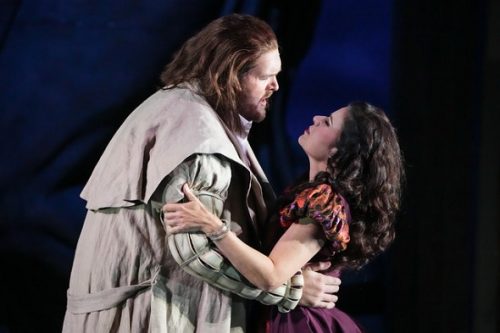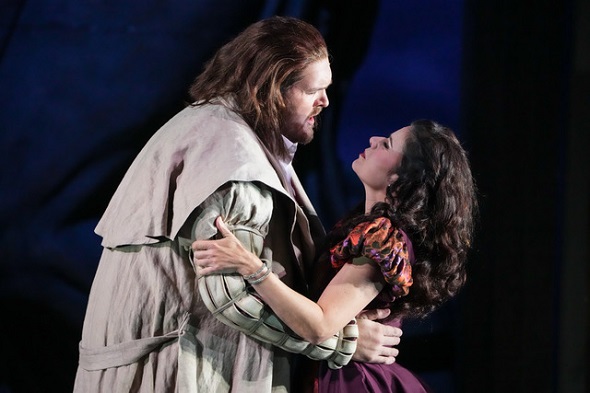 United States Festival O23 [1] – Verdi, Simon Boccanegra: Soloists, Opera Philadelphia Chorus and Orchestra / Corrado Rovaris (conductor). Academy of Music, Philadelphia, 22.9.2023. (RP)
United States Festival O23 [1] – Verdi, Simon Boccanegra: Soloists, Opera Philadelphia Chorus and Orchestra / Corrado Rovaris (conductor). Academy of Music, Philadelphia, 22.9.2023. (RP)

Production:
Director – Laurence Dale
Sets – Gary McCann
Costumes – Fernand Ruiz
Lighting – John Bishop
Chorus Master – Elizabeth Braden
Cast:
Simon Boccanegra – Quinn Kelsey
Amelia – Ana María Martínez
Fiesco – Christian Van Horn
Gabriele Adorno – Richard Trey Smagur
Paolo Albiani -Benjamin Taylor
Pietro – Cory McGee
Maid – Robin Bier
Captain – Toffer Mihalka
Opera Philadelphia’s annual Festival O has been at the cutting edge of reimagining and reinvigorating the genre through the commissioning of new works, innovative approaches to digital formats and exciting productions of the classics. With Verdi’s Simon Boccanegra, the company proves again that it can mount an exciting production of a work in the core repertoire as well as, if not better than, most – especially when it comes to casting.
The convoluted plot of Simon Boccanegra, which is steeped in class conflict and political intrigue, unfolds in a prologue and three acts. Set in fourteenth-century Genoa, the former pirate Boccanegra is catapulted to the office of doge through the machinations of Paolo and Pietro, leaders of the plebeians. Boccanegra hopes that his new position will permit him to marry Maria, the daughter of the aristocrat Fiesco, who is outraged that Maria has given birth to a daughter fathered by Boccanegra. By the end of the prologue, Maria has died and the daughter, also named Maria, has disappeared.
With the passage of 25 years, Boccanegra has exiled most of his aristocratic political opponents. Fiesco, who assumed the alias of Andrea Grimaldi, has raised a girl who was abandoned as an orphan and renamed Amelia Grimaldi in an attempt to preserve the family line. Upon meeting the young woman, Boccanegra discovers that Amelia is his lost daughter, Maria, in one of the opera’s most deftly crafted and touching scenes.
Prior to learning of Amelia’s true identity, Boccanegra had promised her to Paolo as his bride. Amelia, however, is in love with Gabriele Adorno, a patrician who is plotting against Boccanegra. Upon learning that Amelia is his daughter, Boccanegra rescinds the offer of her hand in marriage to Paolo. The rebuffed suitor proceeds to plot Boccanegra’s murder, enflames Adorno with jealousy and unsuccessfully tries to persuade Fiesco to abet him in his scheming.
With rebellion brewing in the city, Adorno, whom Boccanegra has pardoned, agrees to fight on the doge’s side. Paolo, meanwhile, has poisoned Boccanegra. With the populace celebrating Boccanegra’s victory, Paolo is led off to be tortured and executed. Fiesco learns that Amelia is his long-lost granddaughter, Maria, as the dying Boccanegra blesses the young couple and names Adorno as his successor.
Opera Philadelphia imported Laurence Dale’s production of Simon Boccanegra, which was first seen at the Opéra royal de Wallonie in June 2022. Dale updates the action to Italy during the Fascist era, at least in terms of the set.
The opera opens and closes with expansive, evocative sea vistas. Most of the action, however, is placed in an attractive and compact revolving set comprised of what appear to be elements lifted from Rome’s Termini Station. Lighting plays a key and effective role in creating atmosphere and enhancing the drama.

The staging was a bit static, however, and the singers often stood stock-still facing the audience, which meant that there was no trouble hearing any of the cast. Not that it was an issue due to conductor Corrado Rovaris’s sensitivity to balance.
The costumes, however, turn historical accuracy on its head, although they do effectively delineate the economic gulf between the patricians and the plebeians. Boccanegra wears a buff-colored military uniform as well as a traditional doge’s cap, the symbol of his authority. The masses who rally to support Boccanegra are attired in working-class garb. Amelia, Fiesco and other patricians, however, wear fine garments that hearken back to medieval times.
It has been fascinating to watch Quinn Kelsey develop into one of the most compelling Verdi baritones of the day. Vocally, he always had the goods, but the past decade has seen him develop into a fine actor. His take on Simon Boccanegra, undoubtedly guided by Dale, is more conflicted than heroic.
This unease, both on political and personal levels, is underscored by the enormous plinth upon which he ascends to sit precariously upon his throne. As he dies, Quinn’s Boccanegra transcends power and politics, focusing solely on his love for Amelia and her future happiness.
There is a similar tentativeness to Ana María Martínez’s graceful Amelia. Fate has shrouded her past in mystery, while politics portend to control her future. There was nothing hesitant about her singing, however, and her voice bloomed beautifully in ‘Come in quest’ora bruna’, in which Amelia awaits the appearance of Adorno in Act I; and even more so later in the scene when she learns of her true parentage.
There was real excitement surrounding the company debut of the rising young tenor Richard Trey Smagur as Gabriele Adorno, and he did not disappoint. Physically imposing, Smagur has a big voice that easily filled out Verdi’s musical lines. He is a compelling actor as well. It was a fine performance, but one could not help thinking that it would be far better once he got opening night behind him.
As Fiesco, Christian Van Horn impressed with the size and sonority of his bass-baritone voice. Benjamin Taylor chewed up the stage as the duplicitous Paolo: his beautiful voice, especially his free and easy top range, was shown to its best advantage. Pietro is a minor role, but bass-baritone Cory McGee made his mark in this exceptionally strong cast.
Simon Boccanegra may not contain any of Verdi’s popular arias, but the score is replete with enticing melodies and colorful orchestrations. Under Corrado Rovaris’s baton, the orchestra spun lyrical lines as beautiful as any heard from the singers. The brass fanfares, especially from the horns in the final act, were especially fine. Equally impressive was the chorus, who sang and acted with gusto.
Rick Perdian
